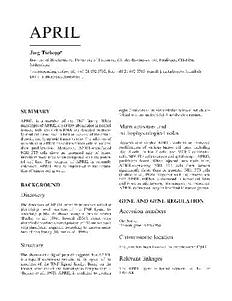Table Of ContentAPRIL
Jurg Tschopp*
Institute of Biochemistry, University of Lausanne, Ch. des Boveresses 155, Epalinges, CH-1066,
Switzerland
*corresponding author tel: (cid:135)41 21 692 5738, fax: (cid:135)41 21 692 5705, e-mail: [email protected].
DOI: 10.1006/rcwy.2000.05011.
SUMMARY eight (cid:12) strands in its extracellular domain, which are
folded into an antiparallel (cid:12) sandwich structure.
APRIL is a member of the TNF family. While
transcriptsofAPRILareoflowabundanceinnormal Main activities and
tissues, high levels of mRNA are detected in trans-
pathophysiological roles
formed cell lines, and in human cancers of the colon,
thyroid,andlymphoidtissuesinvivo.Theadditionof
recombinantAPRILtovarioustumorcellsstimulates Recombinant soluble APRIL leads to an increased
their proliferation. Moreover, APRIL-transfected proliferation of various tumor cell lines, including
NIH 3T3 cells show an increased rate of tumor Raji B cells, Jurkat T cells, and MCF-7 carcinoma
growth in nude mice when compared with the paren- cells.NIH3T3cellsoverexpressingfull-lengthAPRIL
tal cell line. The receptor of APRIL is currently proliferate faster. When injected into nude mice,
unknown. APRIL may be implicated in the regula- APRIL-expressing NIH 3T3 cells form tumors
tion of tumor cell growth. significantly faster than do parental NIH 3T3 cells
(Hahne et al., 1998). Together with the observation
that APRIL mRNA is increased in tumor cell lines
BACKGROUND and in metastatic tumors, this suggests that increased
APRIL expression may be involved in tumorigenesis.
Discovery
GENE AND GENE REGULATION
The discovery of APRIL arose from studies aimed at
identifying novel members of the TNF ligand by Accession numbers
screening public databases using a profile search
(Bucher et al., 1996). Several cDNA clones were
GenBank:
identifiedencodinganovelproteinof250aminoacids
Human gene: AF046888
with significant sequence homology to known mem-
bers of this family (Hahne et al., 1998).
Chromosome location
Structure
The gene has been localized to chromosome 17p13.
The absence of a signal peptide suggests that APRIL
Relevant linkages
is a type II membrane protein that is typical of the
members of the TNF ligand family. Based on the
known structure of the homologous lymphotoxin (cid:11) The APRIL gene is found adjacent to that for
(Banner et al., 1993), APRIL is predicted to contain TWEAK.
500 Jurg Tschopp
Cells and tissues that express Discussion of crystal structure
the gene
Nocrystalstructureisavailable.However,thecrystal
structure of APRIL is expected to be homologous to
Human APRIL mRNA is found in peripheral blood
thatoflymphotoxin(cid:11),CD40L,andTNF(cid:11),forwhich
lymphocytes(PBLs)andprostategland.Expressionis
structural information is available (being an elon-
particularly high in tumor tissues (thyroid and colon
gated, antiparallel (cid:12) pleated sheet sandwich with a
carcinoma,andlymphoma),andincelllines(promye-
‘jelly-roll’ topology, three monomers associating inti-
locytic leukemia, HL-60; HeLa cell S3; chronic
mately about a 3-fold axis of symmetry to form a
myelogenous leukemia, K562; lymphoblastic leuke-
compact, bell-shaped trimer) (Eck and Sprang, 1989;
mia, MOLT-4; Burkitt’s lymphoma, Raji; colorectal
Banner et al., 1993; Karpusas et al., 1995).
adenocarcinoma, SW480; lung carcinoma, A459;
melanoma, G361).
Important homologies
PROTEIN APRIL is a member of the TNF ligand family
(Figure 2).
Sequence
Posttranslational modifications
Theproteinsequence ofAPRILis showninFigure1.
Thereisaputativeglycosylationsiteatasparagine124.
The extracellular region is processed by an
Description of protein
unknown protease (possibly furin), which cleaves
in a highly basic region of the stalk region
APRILisatypeIImembraneproteinlackingasignal (RKRRAVLTQKQKK). The receptor-binding
peptide. domain of APRIL is thereby released.
Figure 1 Protein sequence of APRIL. The transmembrane domain is underlined.
Sequence
Transmembrane domain underlined.
1 MPASSPFLLA PKGPPGNMGG PVREPALSVA LWLSWGAALG AVACAMALLT QQTELQSLRR
61 EVSRLQGTGG PSQNGEGYPW QSLPEQSSDA LEAWENGERS RKRRAVLTQK QKKQHSVLHL
121 VPINATSKDD SDVTEVMWQP ALRRGRGLQA QGYGVRIQDA GVYLLYSQVL FQDVTFTMGQ
181 VVSREGQGRQ ETLFRCIRSM PSHPDRAYNS CYSAGVFHLH QGDILSVIIP RARAKLNLSP
241 HGTFLGFVKL
Figure 2 Alignment comparing seven members of the TNF ligand family.
APRIL 117 VLHLVPINATSKDDS..........DVTVEMWQPA.LRRGRGLQA....QGYGVRIQDAGVYLLYSQVLFQDVT..........FTMGQV
TNFa 89 VAHVVANPQAEGQ...............L.QWLNR..RANALLANGVELRDNQLVVPSEGLYLIYSQVLFKGQGCPS....THVLLTHTI
TXa 64 AAHLIGDPSKQNS...............L.LWRAN..TDRAFLQDGFSLSNNSLLVPTSGIYFVYSQVVFSGKAYSPKATSSPLYLAHEV
FASL 146 VAHLTGKSNSRSMP..............L.EWEDT..YGIVLLSGVKY.KKGGLVINETGLYFVYSKVYFRGQSCN......NLPLSHKV
TRAIL 123 AAHITGTRGRSNTLSSPNSKNEKALGRKINWSESSR.SGHSFLSNLHL.RNGELVIHEKGFYYIYSQTYFRFQEEIK....ENTKNDKQM
TWEAK 143 AAHYEVHPRPGQDGAQAGV......DGTVSWGEKARINSSSPLRYNR..QIGEFIVTRAGLYYLYCQVHFDEGKAVY..LKLDLLVDGVL
TRANCE 164 FAHLTINATDIPSGSH.........KVSLSWSYHD..RGWGKISNMTF.SNGKLIVNQDGFYYLYANICFRHHETSGDLATEYLQLMVYV
PRIL 182 VSREGQG...RQETLFRCIRSMP........SHDPRAYNSCYSAGVFHLHQGDILSVIIPRARAKLNLSPHGTFLGFVKL
TNFa 157 SRIAVSY...QTKVNLLSAIKSPCQRETPEGAEAKPWYEIPYLGGVFQLEKGDRLSAEINRPDYLDFAESGQVYFGIIAL
TXa 136 QLFSSQY...PFHVPLLSSQKMV......YPGLQEPWLHSMYHGAAFQLTQGDQLSTHTDGIPHLVLSP.STVFFGAFAL
FASL 212 YMRNSKY...PQDLVMMEGKMMS......YCTTGQMWARSSYLGAVFNLTSADHLYVNVSELSLVNFEE.SQTFFGLYKL
TRAIL 189 VQYIYKYTSYPDPILLMKSARNS.....CWSKDAEYGLYSIYQGGIFELKENDRIFVSVTNEHLIDMDH.EASFFGAFLV
TWEAK 223 ALRCLEE...FSATAASSLGP...............QLRLCVQSGLLALRPGSSLRIRTLPWAHLKAAP.FLTYFGLFQV
TRANCE 242 TKTSIKI...PSSHTLMKGGSTK.....YWSGNSEFHFYSINVGGFFKLRSGEEISIEVSNPSLLDPDQ.DATYFGAFKV
APRIL 501
CELLULAR SOURCES AND References
TISSUE EXPRESSION
Banner,D.W.,D’Arcy,A.,Janes,W.,Gentz,R.,Schoenfeld,H.J.,
Broger, C., Loetscher, H., and Lesslauer, W. (1993). Crystal
Cellular sources that produce
structure of the soluble human 55kd TNF receptor–human
TNF beta complex: implications for TNF receptor activation.
Many cell lines express APRIL mRNA. There is no Cell73,431–445.
Bucher, P., Karplus, K., Moeri, N., and Hofmann, K. (1996).
report on protein expression.
A flexible search technique based on generalized profiles.
ComputerChem.20,3–24.
Eck, M. J., and Sprang, S. R. (1989). The structure of tumor
IN VITRO ACTIVITIES
necrosisfactor-alphaat2.6Aresolution.Implicationsforrecep-
torbinding.J.Biol.Chem.264,17595–17605.
In vitro findings Hahne,M.,Kataoka,T.,Schroter,M.,Hofmann,K.,Irmler,M.,
Bodmer, J. L., Schneider, P., Bornand, T., Holler, N.,
French, L. E., Sordat, B., Rimoldi, D., and Tschopp, J.
APRIL accelerates the growth of many cell lines. (1998). APRIL, a new ligand of the tumor necrosis factor
family, stimulates tumor cell growth. J. Exp. Med. 188, 1185–
1190.
Bioassays used
Karpusas, M., Hsu, Y. M., Wang, J. H., Thompson, J.,
Lederman, S., Chess, L., and Thomas, D. (1995). 2 A crystal
Thebioassayusedisanincreasedproliferationrateof structure of an extracellular fragment of human CD40 ligand.
Structure3,1031–1039.
Jurkat cells (Hahne et al., 1998).

